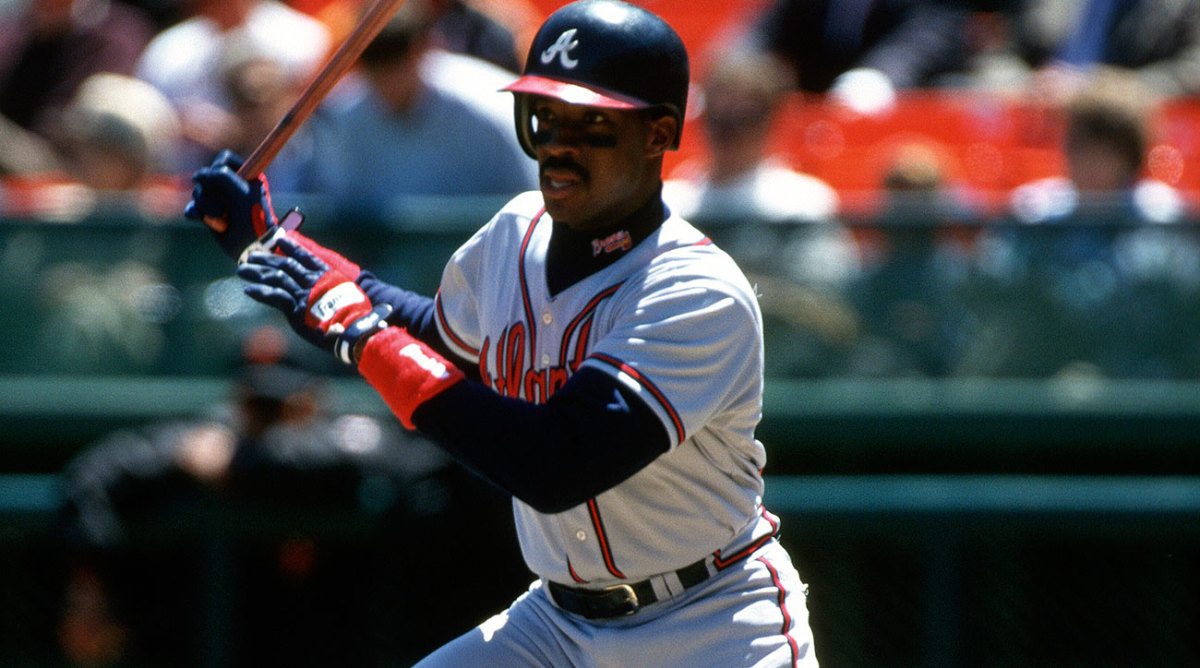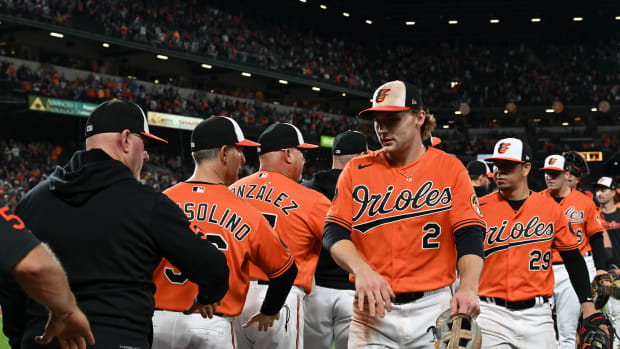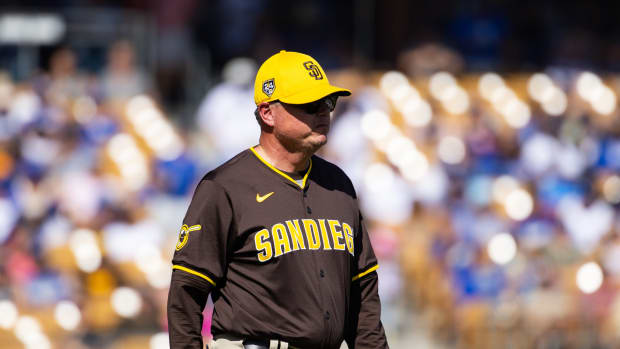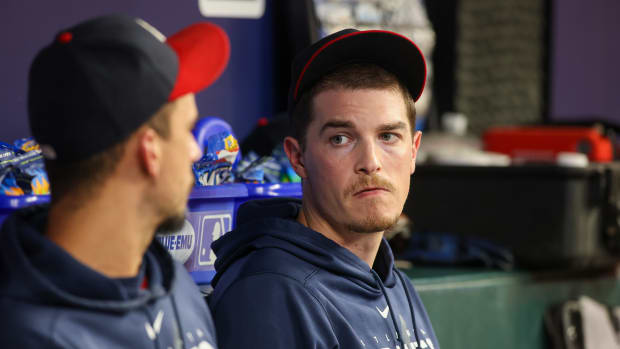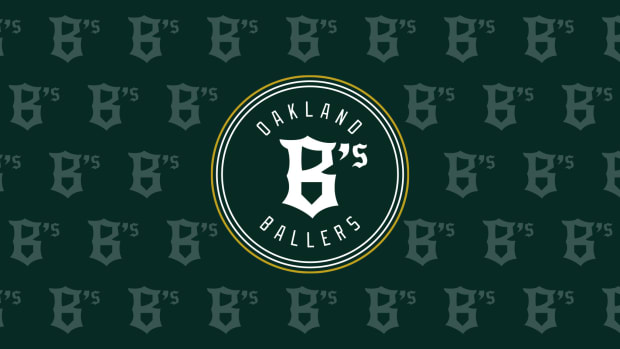JAWS and the 2017 Hall of Fame ballot: Fred McGriff
The following article is part of my ongoing look at the candidates on the BBWAA 2017 Hall of Fame ballot. Originally written for the 2013 election, it has been updated to reflect recent voting results as well as additional research. For a detailed introduction to this year's ballot, please see here. For an introduction to JAWS, see here.
Despite being an outstanding hitter, Fred McGriff had a hard time standing out. Though he arrived in the major leagues the same year as Mark McGwire and Rafael Palmeiro and was the first player to lead each league in home runs since the Dead Ball Era, he couldn’t match the career accomplishments of either of those two men, finishing short of round-numbered milestones with "only" 493 home runs and 2,490 hits. The obvious explanation—that he didn't have the pharmaceutical help that others did—may be true, but it was just one of many ways in which McGriff's strong performance didn't garner as much attention as it merited.
That isn't to say that McGriff went totally unnoticed during his heyday, but some of the things for which he received attention were decidedly ... square. Early in his major league career, McGriff acquired the nickname "the Crime Dog" in reference to McGruff, an animated talking bloodhound from a public service announcement who urged kids to "take a bite out of crime" by staying in school and away from drugs. He also appeared in the longest-running sports infomercial of all time, endorsing Tom Emanski's Baseball Defensive Drills video, a staple of insomniac viewing amid SportsCenter segments on ESPN since 1991.
That those distinctions carry some amount of ironic cachet today is evidence that McGriff might have been just too gosh-darn wholesome a star for an increasingly cynical age. On the other hand, it's far better to be remembered for pointing a finger in the service of a timeless baseball fundamentals video than accompanying sworn testimony in front of Congress. But it hasn’t translated to support from Hall of Fame voters. McGriff debuted at 21.5% on the 2010 ballot, peaked at 23.9% two years later and appears destined to ride out his 10 years of eligibility toward the ballot’s lower reaches. Unfortunately for him, advanced statistics haven’t helped his cause.
player | career | peak | jaws | h | hr | sb | avg/obp/slg | ops+ |
Fred McGriff | 52.4 | 35.8 | 44.1 | 2,490 | 493 | 72 | .284/.377/.509 | 134 |
Avg. HOF 1B | 65.9 | 42.4 | 54.2 |
|
|
|
|
|
A native of Tampa, McGriff grew up just four blocks from Al Lopez Field, the longtime spring training home of the Reds, providing him plenty of access to baseball from a young age. He was a ninth-round pick by the Yankees out of high school in 1981, but like so many of New York's farmhands of that era, he never got to wear the pinstripes. Just 18 months after he was drafted and less than two months after his 19th birthday, he was traded to the Blue Jays along with Dave Collins, Mike Morgan and cash for Dale Murray and Tom Dodd—a move that ranks as one of the worst trades in franchise history.
McGriff made slow progress through the minors, in part because he was blocked by the popular Willie Upshaw at first base in Toronto's lineup. He debuted in the majors on May 17, 1986, though he only stuck around for a three-game cameo and didn't crack the Jays' lineup until '87. Serving as the lefty half of a designated hitter platoon with Cecil Fielder, he hit .247/.376/.505 with 20 homers—the first of 15 times he would reach that plateau—in just 356 plate appearances. Alas, that was the year the Blue Jays fumbled the American League East flag into the hands of the Tigers by losing their final seven games.
The next year, McGriff began a string of seven straight 30-homer seasons, showing amazing consistency with his output: 34, 36, 35, 31, 35, 37, 34. The first three of those seasons came with Toronto, a span in which he produced 18.0 WAR; in 1989, he led the AL with 36 homers and hit .269/.399/.525 en route to 6.6 WAR (fourth-best in the league). Nonetheless, he found himself on an outbound flight as part of a star-studded December 1990 trade that sent him and shortstop Tony Fernandez to San Diego for second baseman Roberto Alomar and outfielder Joe Carter, a move that helped the Blue Jays win back-to-back World Series in '92 and '93. While McGriff missed out on those parties, he picked up where he left off in San Diego: His NL-high 35 homers in 1992 made him the first player since Hall of Famer Sam Crawford (in 1901 and '08) to lead each league (McGwire would later become the second).
JAWS and the 2017 Hall of Fame ballot: Manny Ramirez
The Padres were a .500-ish team for McGriff's first two seasons, but when owner Tom Werner ordered a salary purge in 1993, McGriff—the team's highest-paid player at $4 million—was on the move again, traded to the defending NL champion Braves in July. Atlanta was 53–40 and eight games behind the Giants in the NL West when the deal went down but would go a remarkable 51–18 the rest of the way, winning the West before losing to the Phillies in the NLCS. Settling in as one of the cornerstones of a dynasty, McGriff hit .310/.392/.612 with 19 homers in 291 plate appearances with Atlanta and set a career high with 37 homers overall. He followed that up by hitting .318/.389/.623 with 34 homers in the strike-shortened 1994 season, his seventh straight year ranking among his league’s top five in homers.
Following the strike, McGriff was part of three straight division champions for the Braves from 1995 to '97 and back-to-back pennant winners in the first two of those years. By that point, his regular-season offensive production had taken a significant dip, and with below-average defense at first base (-13 runs according to Total Zone), he was worth a total of just 3.2 WAR from 1995 to '97. Even so, he hit a combined .307/.396/.623 with nine homers and 25 RBIs in the 1995 and ’96 postseasons, with pairs of homers in both Atlanta's World Series win over the Indians in the former year and its loss to the Yankees in the latter. Throughout his career, McGriff excelled in October, hitting .303/.385/.532 with 10 homers in 50 postseason games.
After a 1997 season in which he slumped to 22 homers, -7 fielding runs and 0.2 WAR, the 33-year-old Tampa native was traded to the expansion Devil Rays. He spent 3 1/2 years with the awful team, enjoying a mini-renaissance in 1999 (34 homers, 4.0 WAR) but otherwise merely clocking time in front of sparse crowds while his team was routed. After some initial resistance via the exercise of his no-trade clause—he had two young kids at home and was playing in his hometown—he was swapped to the Cubs in July 2001, and while he again hit well after the move, he couldn't spur them to the postseason. Following his 10th and final 30-homer season in 2002, he spent an injury-wracked year with the Dodgers, causing a “Countdown to History” sign in anticipation of his 500th homer to be mothballed. He returned to Tampa Bay in 2004 and played just 27 games before being released in late July, then officially hung up his spikes when he couldn't find a landing spot for the '05 season.
JAWS and the 2017 Hall of Fame ballot: Vladimir Guerrero
McGriff finished his career with the same home run total as Lou Gehrig, but times had certainly changed. Not only did he fall just a bit short of 500, but he also played during an era where that mark's cachet as an automatic qualifier for the Hall of Fame was obliterated, due not only to the rise of performance-enhancing drugs but also by expansion into high-altitude venues (Colorado and Arizona) and changes in the ball itself. Through 1997, 15 players had reached 500 homers, with nearly all of them gaining entry to the Hall of Fame in short order; since the BBWAA returned to annual voting in '66, only Harmon Killebrew and Eddie Mathews needed more than one year to be elected. Since 1997, another 12 sluggers have joined the club, but thus far, McGwire, Palmeiro, Barry Bonds, Gary Sheffield and Sammy Sosa have failed to gain entry due to their connections to PEDs; Palmeiro fell off the ballot in 2014, Sosa appears destined to do the same, and McGwire aged off the ballot after the '16 cycle. Manny Ramirez (a first-year candidate this cycle) and Alex Rodriguez (eligible in 2022)—both suspended for PED use—may never gain entry.
McGriff stands apart from all that as a player who was never accused of any PED-related wrongdoing. Indeed, he was notorious for his aversion to weight-lifting early in his career. In a 1989 Sports Illustrated profile by Ralph Wiley, Blue Jays teammate Lloyd Moseby noted, "You know that highlight reel that shows the Willie Mays catch and then switches to the fan, who grabs his head with his hands in amazement? Fred McGriff does that to you when he hits a home run. Taking nothing away from [Jose] Canseco and [Mark] McGwire, but everybody knows they lift weights. I wish I could get Freddie to lift weights. The only things he lifts are candy bars."
Despite the lack of 500 homers, McGriff's case for Cooperstown appears to have some merit; he scores a 100 ("a good possibility") on the Bill James Hall of Fame Monitor for his five All-Star appearances, two home run titles and postseason performances, and a 48 (slightly below average) on James's Hall of Fame Standards metric, which similarly credits him for career accomplishments relative to players already in the Hall. That said, McGriff never won an MVP award, had just one top-five finish in the voting and didn't add anything with his defense. “No player ever has tested the merits of 500 home runs more severely than McGriff," wrote Tom Verducci in the June 14, 2004 issue of Sports Illustrated. “McGriff ... has had such an understated and itinerant career that his passage to Cooperstown remains in question.”
JAWS and the 2017 Hall of Fame ballot: Ivan Rodriguez
McGriff is in worse shape when it comes to advanced metrics. His total of 400 batting runs (the offensive component of WAR, relative to a league average hitter) is 56 below the average enshrined first baseman, and that’s before he gets docked for his sub-par base running (-22 runs), defense (-34 runs) and his propensity for hitting into double plays (-13 runs). That suite of numbers backs the notion that he was a fairly one-dimensional slugger. The Hall first baseman to whom he’s closest in batting runs, Eddie Murray (+392)—not a bad comp as a slugger who was never an MVP, though he did attain the dual milestones of 3,000 hits and 500 homers—was similarly below average in base running (-9 runs) and double play (-11 runs), but his defense, which netted him three Gold Gloves, is estimated to have been 61 runs above average, producing nearly a 10-win swing relative to McGriff in that area alone.
In all, McGriff’s 52.4 career WAR is 28th among first basemen, 13.5 wins below the standard and trailing 15 of the 19 who are enshrined. His 35.8 peak WAR ranks 30th, 6.6 wins below the standard—nearly a full win per year—and behind 14 of the 19. His 44.1 JAWS falls 10.1 shy of the standard for first baseman, ranking 31st on the all-time list. That's three notches below Hall of Famer Tony Perez (53.9/36.4/45.2 and a prominent part of the Reds' 1970s dynasty) and two above Orlando Cepeda (50.1/34.4/42.4) but ahead of just three other enshrined first baseman.
Though it would make for a nice moral to the story if McGriff were to gain entry to Cooperstown while those connected to PEDs remained outside, as it is, he just doesn't quite have the numbers. It bears remembering that at least via JAWS, McGriff isn't being measured against McGwire and Palmeiro—neither of whom is even on the BBWAA ballot—but against those already enshrined at his position, such as Gehrig, Perez, Murray, Jimmie Foxx and Hank Greenberg.
Alas, it's not enough, and the voters apparently feel the same way. In seven years on the ballot, McGriff's highest share of support has been the 23.9% he got in 2012, less than a third of what he needs for enshrinement. He fell as low as 11.7% in 2014, and while he gained eight points last year, the annals of modern voting history (since 1966, when the writers returned to annual balloting) lack any precedent for a candidate at 20.9% through seven cycles rallying to 75% given a 15-year eligibility window, let alone a 10-year one.
At best, McGriff can hope that a future Today’s Game Era Committee smiles upon him. Given that that process that hasn’t elected a living ex-player since 2001, nobody should count on that anytime soon.






























